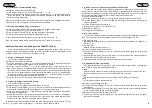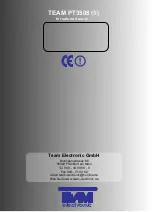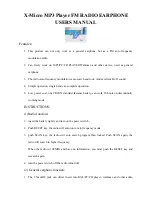
TEAM PT-3508 (3)
manual
table of contents
page
Displays and Controls
2
Set-Up of the TEAM PT-3508 (3)
21
Installing and Removing the Rechargable Battery Pack
21
Installing and Removing the Belt Clip
21
Installing and Removing the Wrist Loop
21
Operation of the TEAM PT-3508 (3) with the Basic Functions
22
1) Turning ON/OFF Your Radio
22
2)
Set Up the Volume
22
3)
Channel Selection
22
4) Transmission
22
5)
Reception
22 - 23
6)
Jacks for External Ear- / Microphone
23
7)
Charging the Rechargeable Battery Pack
23
8) Low Power Alert Function
23
9) Energy Saving Function
24
10) Scan Function
24
Muting Functions of the TEAM PT-3508 (3)
25
1)
General
25
2)
Description of the Procedures
25 - 26
3)
Remarks about the Mute Functions
26
4)
Programming the Different Mute Control Functions
26
5) Monitor Key Functions
26
6)
Transmitting with the Different Mute Control Functions
27
7) Direct Transmission of DTMF Tones
27
8)
Storage of DTMF Strings of Characters
27
9)
Replay a Stored DTMF String Without Transmitting It
27
10)
Transmission of a Stored DTMF String
28
11)
Deletion of a Stored DTMF String of Characters
28
Additional Functions and Settings of the TEAM PT-3508 (3)
28
1)
Setup of the Squelch Threshold
28
2)
Temporary Change of the CTCSS Setting
28
3)
Switch of a Channel`s Transmission and Reception Settings
29
4)
Key Lock Function
29
5)
Display Background Light Setting
29
6)
Time-Out Timer ( TOT)
30
7)
Transmission Lock on Busy Channels
30
8)
Transmit Power Switch
30
9)
VOX-Function
31
General
31
1)
Security
31
2)
Service
31
3)
Declaration of Conformity
31
4)
Programmed Channels
32
5)
Programmed Functions
33
6)
Specifications
33
7)
CTCSS-Tones and DQT-Codes
34
Set-Up of the TEAM PT-3508 (3)
Unpack the PT-3508 (3) carefully. Make sure that none of the following items is missing. Should
any item be defective or missing, please contact your dealer immediately.
PT3508 (3) is a PMR handheld transceiver that can be programmed via the optional software
T-UP2 into a combined PMR-/ HAM-Radio. By default, PT3208 (3) contains only 8 PMR chan-
nels. The indicated channel numbers in the display refer to the according PMR channels that are
listed in the chapter
General
, paragraph
7) Specifications
in the PMR Channel Table.
The transmitting power is set to 500 mW according to the European rules and regulations for
PMR handheld transceivers.
If you want to use the 70 cm frequency band radio channels, a HAM license is required. For
further details about this license and its requirements, contact the government agency for com-
munication in your country that regulates these issues.
If you only use the default PMR channels, no license is required in most of the european coun-
tries.
Installing and Removing the Rechargeable Battery Pack
Installing
Carefully insert the rechargeable battery pack into the opening at the base of the
PT-3508 (3). Turn the rechargeable battery pack in such a way that the "Cauti-
on" label on the rechargeable battery pack will be at the front and the charging
contacts at the rear of the PT-3508 (3). Snap the rechargeable battery pack ( 15 )
into place by pushing until you hear a click. The unit is now ready for use.
Removing
To remove the rechargeable battery pack, turn the rear of the unit toward you.
Push the ribbed latch and, at the same time, pull the rechargeable battery pack
out of the PT-3508 (3).
Installing and Removing the Belt Clip
Attaching
The belt clip is to be attached at the rear of the PT-3508 (3). Remove the two screws
that are located above the label. Position the belt clip with the base pointing to the
bottom of the handheld transceiver and the upper part with the two holes touching
the unit's back part where the screws will be positioned and fasten the belt clip with
the two screws.
Detaching
Loosen the screws, remove the belt clip and put the screws back in position.
Installing and Removing the Wrist Loop
The metal ring for the wrist loop is located above the microphone / speaker jacks
[SP]/[MIC] ( 13 ) on the right side of the PT-3508 (3).
Attaching
Put the thin part of the wrist loop through the metal ring. Through the loop of the
thin part, pull the wide part of the wrist loop and pull until the knot is tight. Refer to
the image.
Detaching
Loosen the knot of the wrist loop at the metal ring and pull the wide part of the wrist
loop out of the loop. Finally, remove the wrist band from the metal ring.
21
ENGLISH
Battery Pack
Belt Clip
Charger
Wrist Loop
Adapter
Manual
Declaration of Conformity
1 pcs. PT-3508 (3)
20
ENGLISH




























